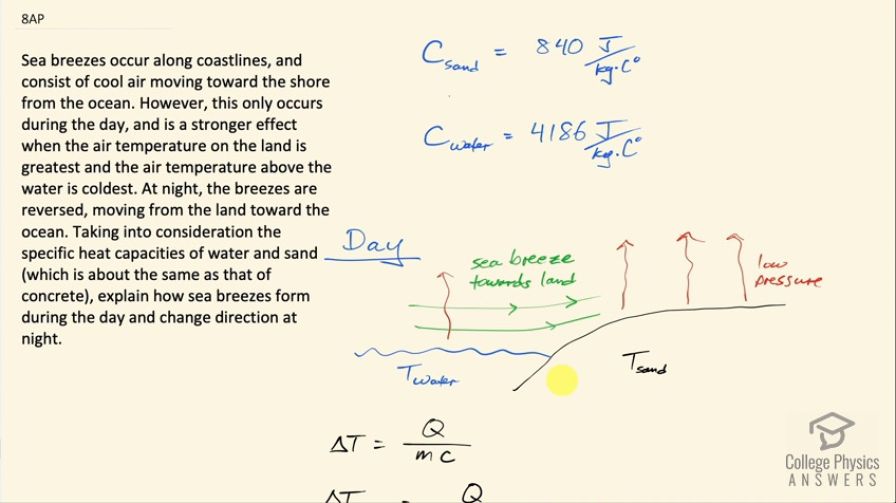Question
Sea breezes occur along coastlines, and consist of cool air moving toward the shore from the ocean. However, this only occurs during the day, and is a stronger effect when the air temperature on the land is greatest and the air temperature above the water is coldest. At night, the breezes are reversed, moving from the land toward the ocean. Taking into consideration the specific heat capacities of water and sand (which is about the same as that of concrete), explain how sea breezes form during the day and change direction at night.
Final Answer
Please see the solution video.
Solution video
OpenStax College Physics for AP® Courses, Chapter 14, Problem 8 (Test Prep for AP® Courses)

vote with a rating of
votes with an average rating of
.
Video Transcript
This is College Physics Answers with Shaun Dychko. We are going to talk about why there's generally a sea breeze towards the land during the day where the land let's suppose has sand on it and we are right beside a huge ocean of water and during the night time, the sea breeze is in the opposite direction going from the land to the sea— I am going to explain it in terms of the different heat capacities of water versus sand. So the heat capacity for sand we're told is similar to that of concrete and that's 840 joules per kilogram per Celsius degree and the heat capacity for water is 4186 so the heat capacity for water is much greater than that of sand. So during the day, the Sun rises and just before the Sun rises, we assume that the water temperature and the sand temperature are the same they have been together in the darkness for the entire night and they have probably reached the same temperature. So in the daytime, the question is which substance will experience the greater change in temperature assuming that they are both starting from the same place? And the change in temperature is the amount of energy absorbed which is thermal energy from the Sun divided by mass and then divided by specific heat capacity and we'll assume that they are both really massive and we are just considering like a unit mass and so we'll make m the same for both but the specific heats are certainly different and so the temperature change for sand is the energy from the Sun divided by mass divided by specific heat of sand and for water, it's the same except we have a specific heat of water here and the magnitude of the temperature change for sand is going to be much greater than the magnitude of the temperature change for water since the denominator is smaller. So the smaller denominator, you have a larger quotient and yeah... specific heat of sand is less than that of water. Now I put these absolute value bars around here because we don't know whether Q is positive or negative and depending on the parts of the day, the sign will change. So during the day, Q is greater than zero because the Sun is giving energy and it's giving energy at an equal rate to both the sand and the water and Q is greater than zero. So that means ΔT is greater than zero and this temperature change of the sand is positive and greater than the temperature change in water and that causes the air above the sand, which will absorb some of the sand's heat to rise up more than the air above the water so I have these red lines representing the rising warm air and it's getting warmed by conductivity or contact with the sand or the water and three lines here represent more updraft versus above the water and this is because the sand is going to be hotter than the water. This greater updraft above the sand will cause low pressure and then the air above the water will rush in to fill this low pressure so high pressure moves towards low pressure and this is a sea breeze. Then we can talk about night time and we have Q is less than zero so the Sun has set and now both of these substances—water and sand— are losing heat and the sand will have a greater magnitude temperature change for a given amount of heat loss than the water will and so the sand will become cooler faster and so there's only one updraft line here whereas there's now three above the water because the water is comparatively warmer than the sand and there's air rising more above the water now and then that creates the low pressure above the water and so high pressure air above the sand will rush in to fill the low pressure above the water and this is now a sea breeze towards the ocean at night.